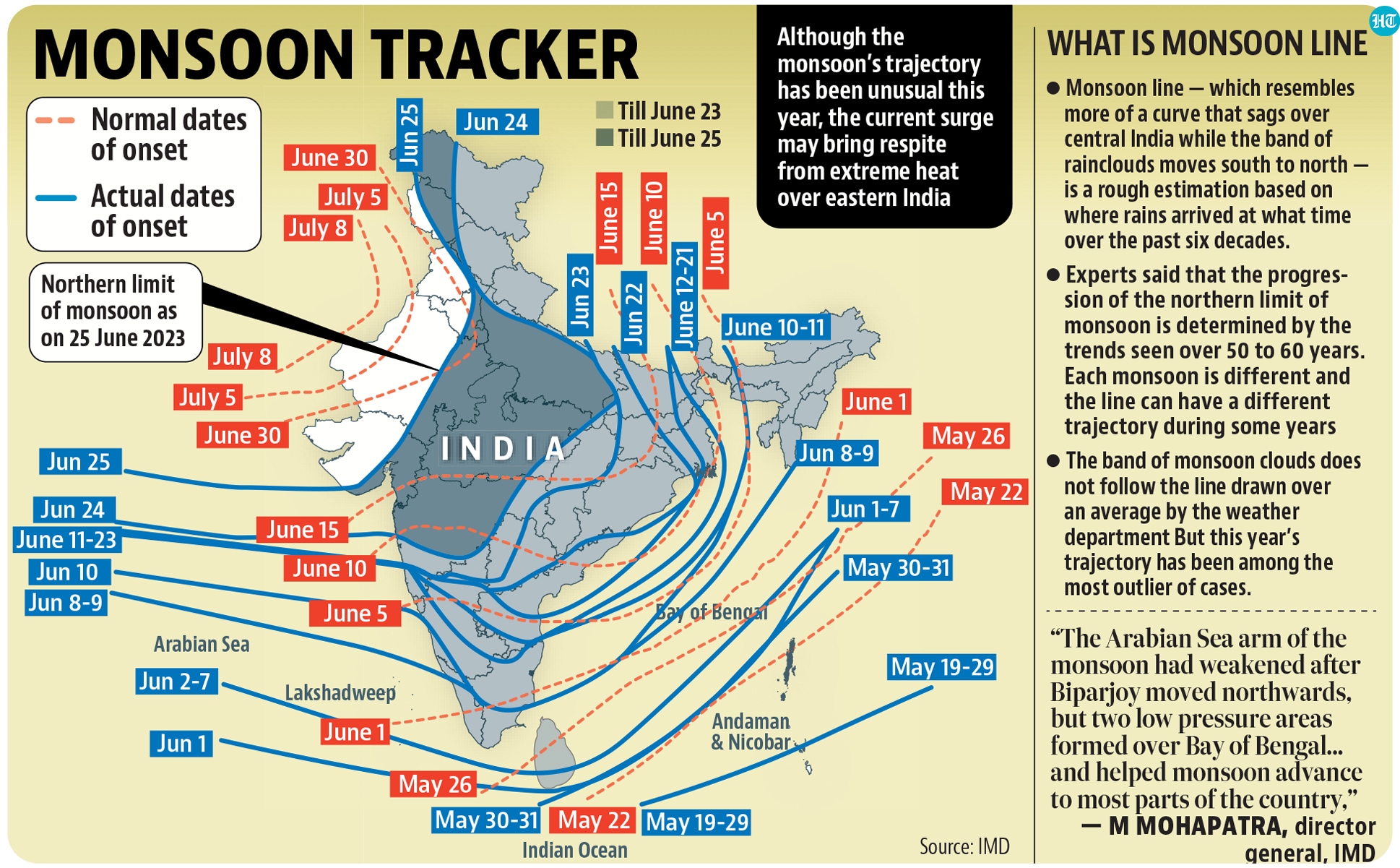Unusual pattern sheds light on how monsoon line takes shape
Until a week ago, the sluggish movement of the monsoon line had raised concerns about the impact of an extremely delayed progress
The monsoon is sprinting. Two days ago, on June 23, the northern limit of monsoon (NLM), or the peak of the monsoon line, had only covered peninsular and part of east India — but on Sunday, it blanketed nearly the entire country, leaving only parts of Gujarat, Rajasthan, Punjab.

Until a week ago, the sluggish movement of the monsoon line had raised concerns about the impact of an extremely delayed progress of India’s annual summer rains, the lifeblood of the country’s rain-fed farmlands, and in turn, a large part of the economy.
Read | Number Theory: Is monsoon performance in June a cause for worry?
Experts explained that the monsoon line — which resembles more of a curve that sags over central India while the band of rain clouds moves south to north — is a rough estimation based on where rains arrived at what time over the past six decades.
“The normal progression of the northern limit of monsoon has been determined by the trends seen over the past 50 to 60 years and hence you see a smooth progression of the line. Each monsoon is different and this line can have a very different trajectory during some years,” said M Mohapatra, director general, IMD.

Also read | Southwest monsoon covers Pune, Mumbai
In reality, then, the band of monsoon clouds does not follow the line drawn over an average by the weather department. But this year’s trajectory has been among the most outlier of cases.
“If you notice, the Arabian Sea arm of the monsoon had weakened after Biparjoy moved northwards, but two low pressure areas formed over Bay of Bengal, one of them was a week ago which helped monsoon progress over entire northeast India, and another that formed today and helped monsoon advance to most parts of the country,” added Mohapatra.
This meant that this year, the monsoon line has resembled anything but the average, plotted out with data from 50-60 years.
Mohapatra added that the line can often also misrepresent what people actually experience. “NLM represents the extent of the country up to which monsoon wind pattern has established and there is continuity of rainfall over that region. Patchy rain cannot be counted as monsoon coverage and hence the line will not pass over that region,” he explained.
On June 10 the monsoon line was cutting through Karwar, Mercara, Kodaikanal, Adirapattinam and Dhubri when it should have ideally covered all of peninsular India, most of the west coast and northeast India.
One of the main reasons for such an unusual pattern, as HT reported citing experts on Sunday, was the formation of cyclone, Biparjoy on June 7, which made landfall over Kutch, Saurashtra and adjoining Pakistan coast on June 16. It continued to be a depression, traversing eastward, and the remnant of Biparjpoy was lying as a cyclonic circulation over Uttar Pradesh till Saturday.
This essentially sapped away moisture from the Arabian Sea, which feeds the monsoon rains on the west coast.
But, on Friday and Saturday, both the Arabian Sea and Bay of Bengal arms of the monsoon were activated, creating an east-west trough from north Punjab to northwest Bay of Bengal, which cut across Haryana, south Uttar Pradesh, northeast Madhya Pradesh, north Chhattisgarh and north Odisha — all of which received rains.
“Monsoon has two branches and the activation of both sides — the Arabian Sea arm which helps monsoon enter India’s west coast and the Bay of Bengal arm which helps bring easterlies and monsoon rain over northeast and east India are important for proper advance of monsoon over the Indian landmass. We know that the Arabian Sea arm of monsoon was disturbed because of Biparjoy. It remained weak for several days. The convergence of these two arms is needed for monsoon conditions to be active. We are seeing that happen only now,” explained DS Pai, senior IMD scientist.

All Access.
One Subscription.
Get 360° coverage—from daily headlines
to 100 year archives.



HT App & Website






